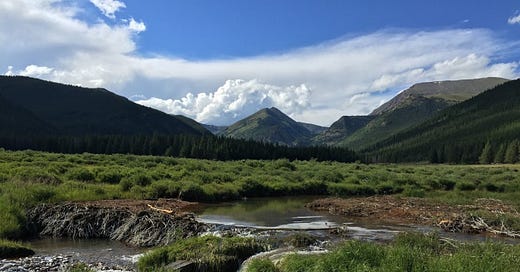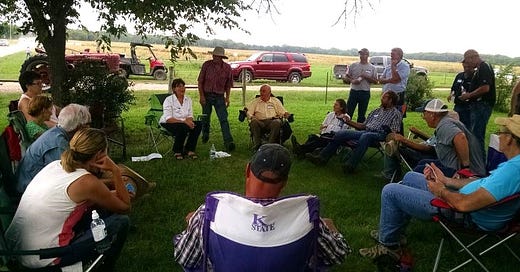

Discover more from The Wisdom Underground
The Biotic Climate and the Soil Sponge
How Life Regulates Temperature, Weather, and the Climate through the Water Cycle
Heatwaves, drought, flooding, and wildfires don’t just “happen to us.” Nor are they just “symptoms” of global warming. Life regulates the Earth’s weather and climate, and our relationship with the biological workforce affects the weather and climate.
Life knows how to make clouds and rain; spread rain evenly across continents; infiltrate rain into soils; massively cool the air around us; turn water into lovely dew and mists and snowflakes; keep our planet from freezing or burning up as we spin through outer space; and create moist green landscapes where trees and grasses don’t easily burn.
We have taken that agency away from life through our land management (tillage, creating monocultures, and killing off anything we think is a problem). Through our land management we can also let life return to its sacred work of creating an incredibly welcoming green and blue planet.
To do this, we need to increase our ability to image the processes of life at work. (Observing living systems at work regularly and consciously, until we are able to bring a realistic image of those processes into our minds at will, as we make decisions.)1
There are two big concepts that I find really useful. The first is what I call the Biotic Climate.2 The second is what I call the Soil Sponge. These concepts have been missing from nearly everyone’s understanding of agriculture, planning, design, and policy—and the disastrous effects can be seen worldwide.3
By deepening our understanding of these two concepts, we have a chance of rapidly re-regulating the climate, and creating regional oases, (and eventually a whole planet) that can offer shelter from the storm, and abundant food and water for all of life.
Key Processes of the Biotic Climate
Plants feed the workforce: Plants take CO2, water, a tiny fraction of minerals, and use solar energy to create themselves, and feed the entire biological workforce above and below ground, on land and in the oceans.
Plants create oxygen so life can breathe.
Life builds a water-holding sponge out of rock particles: Plants, fungi, and many other species take rock particles and turn them into a sponge-like matrix that soaks up rain and slowly releases it for all of life on land, while protecting it from evaporation.
Life keeps soils intact during weather events: The biological glues and threads that make up the soil sponge keep mineral particles and landscapes intact even when wind blows, heavy rain falls, or land is submerged temporarily in floodwater.
The soil sponge regulates underground temperatures: The air and water held in the void spaces of the soil sponge act as an insulating buffer to keep soils cooler in summer and warmer in winter: regulating the temperature for life both underground for and above ground.
Plant transpiration cools the air: Plants and trees transpire (like sweating) whenever the sun is shining and they are photosynthesizing. As that liquid water evaporates from leaves, it becomes water vapor (an invisible gas). This phase change from liquid to gas cools the plants and the air around the plants, turning “sensible heat” (that you can feel), into “latent heat” that won’t warm the air again until the water recondenses, higher up in the air. This cools the leaves of the plants, cools the air, and regulates temperatures for above ground life. A study from Turkey showed that the air above a green transpiring landscape is on average 5.3 degrees C (9.54 degrees F) cooler than bare soil, and 11.79 degrees C (21.42 F) cooler than pavement.4
The “biotic pump” moves moist air across continents: Low pressure zones form over cooler, greener landscapes, and help to draw moist air inland from coasts. This means rain can spread out more evenly across a continent, and storms don’t linger as long and are less violent.5
Biological condensation nuclei form mists and clouds: Trees and other plants produce various airborne particles. Transpired water vapor needs these particles as a surface on which they can recondense into suspended liquids (mists and clouds). These particles include Volatile Organic Compounds (VOCs), the wonderful compounds you smell in the air when walking through a forest or smelling flowers and plants in a diverse landscape, such as pinenes, terpenes, limonenes. Pollen and other tiny floating particles can serve as condensation nuclei as well.
In the oceans, plankton produce Dimethyl sulfoniopropionate (DMSP) which is broken down by bacteria into Dimethyl Sulfide (DMS) which acts as the main condensation nucleus for cloud formation over oceans. Plankton help regulate cloud formation and local temperatures by producing more DMSP when they get excessive exposure to sunlight. Likely forests do the same through release of VOCs.
Clouds and plants provide shade to cool the Earth’s surface: Thick fluffy clouds created by life provide shade that cools and protects the surface from absorbing too much heat during the day. Trees and plants do the same, closer to the ground.
Microbes help create rain and snow: Airborne microbes (released from healthy grasslands and forests) act as precipitation nuclei that condense tiny water droplets suspended in clouds into much larger drops and ice crystals that are heavy enough to fall out of the sky as rain and snow, returning water to the Earth.
Rain clears the skies for nighttime cooling: As mists and hazes condense into clouds and rain each day, evening skies are clearer. The heat that has been absorbed during the day can radiate back out to space each night. (The largest increase in global temperatures is the increase in nighttime temperatures.)6
Plants condense dew: Temperature differences between night and day help water vapor in the air to condense on plants and other surfaces as dew, providing additional water for plant growth, and regulating humidity, even in areas with minimal rainfall.
Dew evaporates from plant leaves into morning mists to prime the daily rain cycle.
The soil sponge grows deeper: With more moisture in the ground from rain and dew, more plants can stay green for longer, which provides the materials and workforce to grow a deeper soil sponge. (There is more on this further along in this article.)
Life regulates the atmosphere: Water, carbon, oxygen, nitrogen, methane cycle through life and sky, growth and respiration, and form just the right greenhouse effect to keep us all from freezing or boiling.
The Anti-Biotic Climate
How have we gotten in the way and created our current climate and weather?
Human decisions lead to bare soils, deforestation, and massive losses in the biological workforce.
Machinery breaks up the sponge structure of soils, and compacts it so that it can no longer absorb water.
Pesticides kill off the workforce that could rebuild the sponge.
Monocultures and bare soils starve the remaining underground workforce.
Without a soil sponge, rain is not absorbed and water moves sideways, leading to flash flooding, followed by drought. Water tables drop, soils become dry.
Lack of water means plants can’t photosynthesize (and regulate atmospheric CO2 and water vapor) or transpire water to cool the air directly. This leads to hotter local and regional air temperatures.
Soil temperatures rise—due to the lack of shade, moisture, cooling transpiration, and the loss of the insulating effect of the soil sponge structure—creating unlivable conditions for life underground.
Water evaporates more quickly from the hotter soil surface, and soil moisture decreases further.
Bare dry soils and paved areas absorb more heat from the sun, and radiate dramatically more heat into the air. (See the Stefan Boltzmann equation.)
Heat domes with high pressure form over these areas, and block the movement of rain clouds: creating larger, longer storms near coasts, and more severe drought inland.
Without plant cover and biology to hold soils together, soil erodes in wind and rain. Water and air pollution worsen.
Water vapor in the air now condenses onto pollutants (from burning fuels and wildfires) and onto dust (from eroded soils), creating humid hazes that trap the intense heat radiating from bare soils and pavement, without offering the cooling shade of high albedo clouds.
With fewer grasslands and forests, there is less production of biological condensation and precipitation nuclei and it becomes harder for rain clouds to form, and harder to turn humid hazes into clouds and rain.
With persistent haze, and no rain, skies aren’t clear at night, and the heat that has been stored during the day in soils and pavement cannot escape. The “nighttime radiation window” remains closed.
With less variation of night and day temperatures dew is less likely to form, and plants lose another source of water.
With less rain and dew, and less of a soil sponge to absorb and store water, annual plants have a shorter season of green growth, which warms the air due to lack of transpiration.
The shorter the green growing season, the less food there is for the above ground and below ground workforce to regrow the soil sponge.
Trees become drought stressed, are more prone to diseases and insect predation, and wildfires are more likely–worsening air pollution and heat trapping hazes.
Fire and tillage turn carbon that used to be stored and cycling through living plants and soil biology back into CO2 through oxidation.
Animals are confined away from grasslands, and methane remains in the atmosphere longer due to lack of transpiration, fewer hydroxyls and soil-based methanotrophs.
Repeat until water leaves the planet entirely, or until you realize there is another simpler way: to let life do its work.
“The Soil Sponge”
The soil sponge is how life keeps water on land, and it is foundational for all of the processes that depend on water. Without a healthy soil sponge, life cannot survive or thrive on land.
What is it? The soil sponge is the biological arrangement of tiny broken down rocks (sand, silt and clay) into a sponge-like matrix that has structural and functional integrity. It is created by plants and by life underground.
It has two essential qualities that seem unlikely to exist at in the same structure, but that’s what makes a soil sponge (and a kitchen sponge) so amazing:
It absorbs, infiltrates, and holds water in its pores. The pore spaces form when life (roots, fungi, earthworms, and all the underground inhabitants in a life-filled landscape) moves through this sturdy matrix that keeps these tunnels from collapsing.
It is also water resistant so it doesn’t fall apart. The mineral particles are held together by plant root hairs and fungal hyphae, and by biological slimes, biofilms, and glues. The biological slimes that hold soil aggregates together are water resistant (ever tried to wash a biological slime–like raw egg or mucus–after it has dried and hardened?)
In a vibrant landscape, all of life contributes ongoingly to building, repairing, and maintaining a soil sponge.
Measuring the Structural and Functional Integrity of your Soil Sponge
You know you have a soil sponge forming if:
You can see aggregates (little clumps) of various sizes forming on roots, and within the soil itself.
The soil looks more and more cake-like. Pore spaces and voids are forming and maintaining within the soil (bulk density decreases, compaction decreases, easier to stick a shovel into, and easier to pull a carrot out of)
The soil soaks up rain more and more easily, infiltration rate increases, and surface puddling decreases.
The soil holds together when it is submerged in water: it has “aggregate stability.”
The soil doesn’t blow away with high wind, or erode when water moves over it.
Plants are healthier, tastier, and less likely to spoil, both in the field and after harvest.
You can find more measures of soil sponge structure and function here: https://www.landandleadership.org/fact-sheet-measure-soil-structure.html
Flour versus Bread
You have probably seen my flour versus bread demonstration.7 A plate of flour is like a landscape where the sponge is degraded back into separate mineral particles with no structural or functional integrity because there is no biology holding those particles together. The flour will blow away with wind, and erode even with a gentle rain (and cause landslides in heavier rain). It doesn’t let rain soak in, so the runoff of rain leads to both flooding and drought. Lack of water at the root zone for plants leads to a shorter green season and less transpiration, and higher air temperatures. It also leads to water stressed plants that are more prone to disease and that become fuels for wildfire. Wildfire risk is compounded by the fact that leaves and branches don’t rot because there isn’t enough moisture in the soils to support saprophytic fungi and other decomposers.
Contrast this with the biologically active soil sponge landscape: represented by a plate with several stacked up slices of bread. A soil sponge (like the bread) stays in place in wind and water. If you rain on the bread, the land stays intact and soaks up the water, preventing both flooding and drought, protecting the water from evaporation, and keeping water at the root zone for plants to photosynthesize and transpire. The water is cleaned by the carbon filter of the sponge as it slowly seeps down and sideways—creating abundant groundwater for all of life, and clean springs, ponds, lakes, and rivers. Soil life knows how to feed and grow more life, to find and deliver bioavailable nutrients for life to thrive, and decompose plants before they have a chance to catch fire.
What is the potential here?
If we can understand, effectively teach others, and change our land management to allow for biological work and soil sponge formation, what new potential does that open up?
We could massively cool and rehydrate whole regions quickly
We could prevent much of the flooding we see
We could drought proof our farms
We can grow food even with minimal rain8
We can clean up rivers and lakes and oceans
We can create abundant food, water, and health, for all life.
We are doing this work, and welcome you to join us.
(An earlier version of this article appeared in Green Cover Seed’s Soil Health Resource Guide.)
Footnotes and further resources
If you want a place in which to grow this ability, consider joining one of my live discussion courses, and/or the weekly meetings of the Land and Leadership Development Community, at www.landandleadership.org and lali.teachable.com.
My Australian colleague Walter Jehne of Regenerate Earth has been a key inspiration in showing Earth’s climate as a flow of interrelated biological processes that drive physical and chemical processes. Here’s a video of his take on bio-hydrological approaches to cooling, at our conference in 2016.
For a fascinating history of how climate science let go of its land-based understanding, while retaining atmospheric modeling and research, read Rob Lewis’ recent article “Millan Millan and the Mystery of the Missing Mediterranean Storms.”
Yilmaz et al, Determination of temperature differences between asphalt concrete, soil and grass surfaces of the City of Erzurum, Turkey. April 2008 Atmosfera 21(2)
See Anastassia Makarieva’s work, explained here in an interview with Alpha Lo.
https://www.climatecentral.org/climate-matters/sweltering-summer-nights-2023
Understanding Soil Health and Watershed Function is 150 pages of free curriculum that includes this demo.
The Andhra Pradesh Community Managed Natural Farming Initiative in India has taken up pre-monsoon dry sowing along with their agroecological land management, and are effectively growing food before the rainy season, doubling many farmers incomes and providing food security.
Subscribe to The Wisdom Underground
To reveal what's unseen and unheard, uplift what is undervalued, and evoke metanoia as we move through the world(s) .















Thank you Didi, look forward to seeing more from you on here!
Beautifully put as always when you speak about these things.